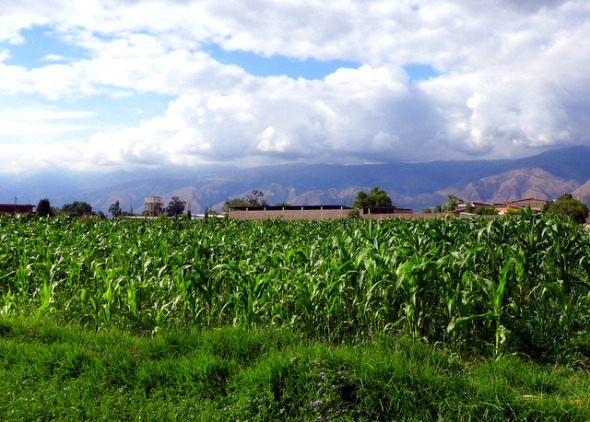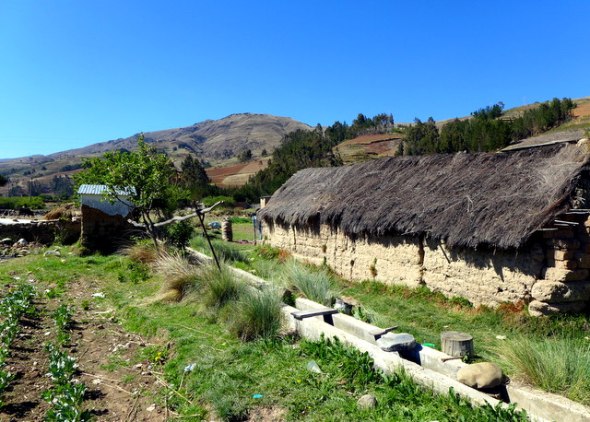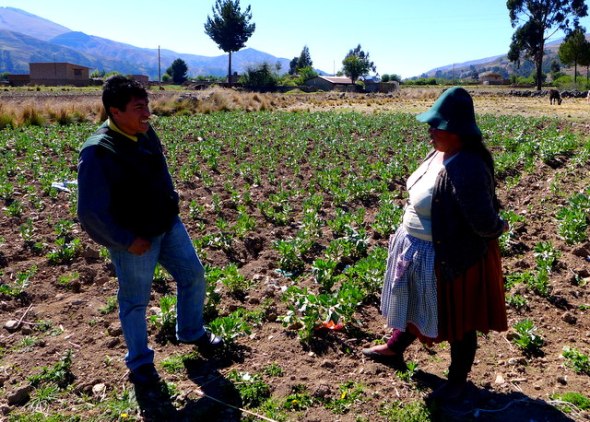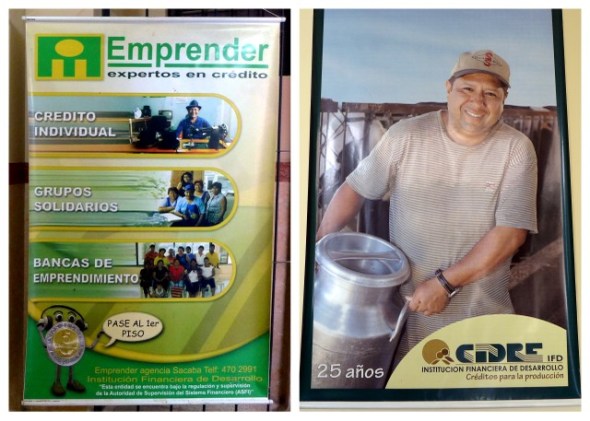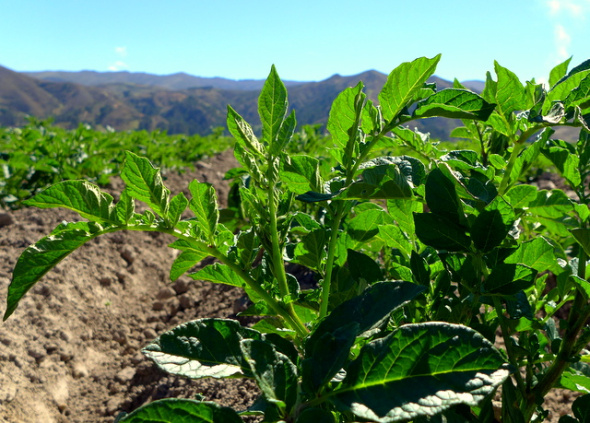Elusive Cash Cows and Bread Baskets: Challenges Facing Bolivian Farmers Today
November 20, 2012

Agriculture has long been the anchor for the people of land-locked Bolivia. As a testament to the region’s horticultural richness, the number of foods originating here is impressive: potatoes, chili peppers, peanuts, pineapple, kidney beans, manioc, quinoa… foods we all know and should love.
And nowhere else in Bolivia is farming as vital as in the Central Valleys near Cochabamba, an area blessed with ideal climate and naturally rich soils. This is where I have been working with CIDRE, one of Kiva’s partners, and I am learning much from Kiva borrowers (quite literally) in the field.
The Incas colonized Cochabamba to help feed its growing empire. Then the Spanish arrived, introduced dairy farming and exploited the Quechua locals with the hacienda system. The conquistadores’ pressing concern was to provision the Potosí silver mines which provided much of the wealth to world-power Spain.

Incan ruins of Incarakay, a pre-Columbian agricultural administrative center, perched atop the fertile Cochabamba Valley
Today much of the land has been redistributed more equitably and farming continues to fuel the Cochabambino economy.
But there are powerful challenges:
Land: Low Supply, Rising Prices and Deteriorating Quality
While the 1952 Revolution in Bolivia went a long way in granting peasant farmers their own plots, the last decade has seen land prices increase dramatically due to urbanization, limited turnover since family plots rarely change hands, and increased demand from migrants seeking better opportunities in the Cochabamba area.
Rising prices have encouraged some farmers to sell, usually to larger landholders and cash-flush immigrant Bolivians returning from abroad. This all adds up to great demand for land but low supply for most Bolivians.
Soil degradation is another major problem. Years of deforestation, excess grazing and rapid urbanization cause heavy erosion that washes away valuable nutrients needed to strengthen the soil. Decreased land productivity requires more chemical fertilizers and genetically modified seeds, resulting in higher costs to farmers and arguably less healthy food for consumers. It puts at risk the lives of countless rural Bolivians who depend on the land for their survival.
Water
Advances in past decades have greatly expanded farmers’ access to water for irrigation. Kiva’s partner CIDRE did some pioneering work in the 1980’s to introduce wells and canals to under-served rural areas. Most farms now yield three crops per year, an increase from 1-2 previously.
But adequate supply of clean water is still a concern: expanding (and thirsty) urban centers, shrinking glacier-fed sources, and a sharp increase in contamination are limiting factors. Cochabamba’s Water War of 2000 made international headlines when massive popular protests halted the privatization of the public water works.

Kiva borrower with me in his bean farm. He used his loan to buy a share in the community irrigation system.
Without water there is no growth. Sadly, the water problems facing Bolivian farmers have few real solutions today.
Climate Cycles and Change

Chacaltaya, Bolivia’s only ski area, has been closed for years due to lack of snow (Photo courtesy Cambio Climático/The Democracy Center)
Weather in Bolivia has long been extreme: a long dry season (usually culminating in drought) and a saturating rainy season. Many parts of Cochabamba’s valleys flood during the months of December to March which dramatically reduces available pasture. Moving cattle to higher elevations, pasture rental and additional fodder all increase the costs to farmers during this period when dairy production (and income) is low.
Global factors compound these normal patterns. Bolivia’s glaciers are disappearing. Unprecedented shifts in weather, such as more frequent hailstorms, can wipe an entire crop in minutes. Severe thunderstorms obliterate fields and collapse stables. Gradual warming in the higher altitudes, while allowing for a more diverse crop portfolio, has introduced new pests and other problems that leave local farmers unprepared.
You don’t have to listen to scientists if you don’t want to. Just ask the farmers: climate change in Bolivia is real.
New Demands for Dairy Producers
As consumer demand for dairy products has grown, so too have the burdens on Bolivian farmers. Few alternative outlets exist so most dairy farmers must sell crude milk at increasingly lower prices to large-scale industrial producers, such as the behemoth Pil Andina. While industrial producers have introduced new quality controls which lead to healthier and safer dairy products, farmers must pay for more expensive production methods which squeeze profits.

A Kiva-funded milk tank allows teams of dairy farmers to better control crude milk quality and fetch higher prices
Only farmers who can achieve greater economies of scale are doing well. Smaller farmers face extinction. As a consequence of newer technology (fortified feed, milking machines, and storage tanks) there are fewer manual jobs which hits landless peasants especially hard.
International Barriers
Bolivia faces tremendous hurdles in getting its agricultural products to markets abroad. Stiff competition with far-more-industrialized Argentina, Brazil and Chile (who also control access to ports) puts Bolivia at a distinct disadvantage with regional partners.
Moreover, the recently-expired Andean Trade Promotion and Drug Eradication Act (ATPDEA) which favored Bolivia with duty-free status, no longer covers nearly 30% of Bolivian exports to the United States. Several people told me this as yet another uncertainty facing Bolivian farmers today.
Finally, agricultural production is far below optimal levels. Many farmers still till their fields with wooden plows dating from the colonial period. And massive emigration in recent years of able-bodied Bolivians has left many fields fallow. Bolivia doesn’t normally produce a surplus but when it does the transportation costs to ship the goods abroad neutralize its competitive advantage in price.
Despite all this, what seems to work for farmers in the region?
Many take out small loans, frequently with the help of Kiva, to help manage the agricultural ups and downs. They invest in feed futures to avoid spiking prices during drought. They use the extra capital to build stables, drainage ditches and sustaining walls to protect their farms from the rains.

Locally produced quesillo cheeses for sale in Cochabamba markets, products that help dairy farmers earn extra income.
Some supplement their income with non-farm work, such as construction or transportation. Others cultivate niche products, such as preserves, honey or quesillo cheese to sell at local markets.
Others turn to the community and leverage the collective power of farmers. They join farmer cooperatives to purchase storage tanks to aggregate products for higher prices or pay for shares in community-owned reservoirs and irrigation canals.
Farmers are an enterprising bunch and manage to find ways to move forward.
So, what does the future look like for farmers here?
Despite continuing urbanization and many young Bolivians finding work in the cities, there is a farming future here. The national government has few resources to carry the agricultural sector to a profitable and sustainable future, but many NGO’s are working hard to help bridge the gap.
Of course, Kiva’s field partners in Bolivia have a strong history of helping farmers grow their businesses and succeed in spite of the environmental and economic challenges. They continue to offer innovative funding options to clients with the help of Kiva loans.
One of the first dairy production projects in Bolivia, the Simón I. Patiño Foundation on the outskirts of Cochabamba offers state-of-the-art research on non-GMO plants, a seed center, and model dairy farm. It eminently influences farmers in the area.
Other organizations are working with farmers to develop soil stability and crop diversification programs, such as planting barrier and cover crops (i.e. supporting grasses and legume “green manures”) to increase soil fertility without chemicals.
Many other groups, such as the Foundation for Sustainable Development, are expanding the capabilities of nonprofit organizations to implement other sustainable solutions that include and empower local communities.
The future of farming in Bolivia may not seem entirely bright. But with steady progress in recent years on increasing environmental awareness in the general public and implementing lasting changes in the agricultural sector, the future promises to be green!
PREVIOUS ARTICLE
Lender Spotlight: Bringing learning to life through Kiva →NEXT ARTICLE
Giving Thanks for New Opportunities in Benin and Togo →

